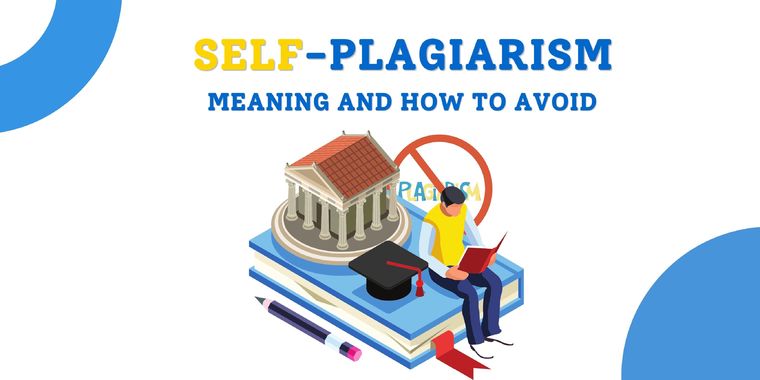Can you plagiarize yourself? Is it possible to use the same paper for two classes? What if a student takes parts of their own work from one class and tries to use it again for something due in another class?

Many students have wondered about these same things. It is okay to use your own work, ideas, research, concepts or theories again and again as long as you are presenting it in new ways or adding to your existing work. Sometimes it cannot be helped. But sometimes it might be something more. How can you know for sure?
This issue is full of philosophical questions and often a source of academic debate. There is often a fine line. But in some cases, depending on if your previous work has been published or not, depending on how much of this old and previously published work you use, this is not an okay practice to engage in. It is known in the academic world as self-plagiarism.
In this article we will explore the concept of plagiarizing yourself, the difference between self-plagiarism and plagiarism, and learn some tips to avoid committing self-plagiarism in your assignments.
What is Self-Plagiarism?
Self-plagiarism is more than just taking your own ideas and using them again. You can surely write about your own concepts in many different works, using as many different ways as possible. Many academics talk about their research, ideas, theories or all of the above in paper after paper. This is not a crime and it is common. We often have an idea that grows and changes as we do more research, or something that is so fundamental to all of our work that we have to talk about it again and again.
People usually have an understanding of plagiarism, or the taking from others, stealing the words and works of others and then trying to say that it is your own work. Students learn about plagiarism early and often and for good reason - no one wants to be accused of it, and no one wants to suffer the consequences of it.
When it comes to defining self plagiarism the issue is a bit more complex. Self-plagiarism involves using your own previously published work, repackaging it a bit, and then trying to submit it to someone or something else and pass it off as new. So to break this down it has to involve a previously published work, something you have gotten into a journal or publication. And it involves you trying to shop this same piece, or large chunks of it, to a different publication as something new or different. And this is not ethical.
As an example let’s say you have written a paper about the benefits of wearing sunscreen even in the winter. A magazine has published your paper and that makes you happy. Another magazine asks you to write about the same topic, so you figure since you’ve already written about this subject, may as well send that second magazine the same published paper. But in doing so you are guilty of a duplicate publication, or, self-plagiarism and this will have an impact on your reputation and the interpretation of how ethical you may or may not be when it comes to writing and research.
We will expand on the self plagiarism definition a bit more as we discuss the issue more and give you tips and tricks on how to avoid both plagiarism and self-plagiarism in your writing and work.
How is self-plagiarism different from plagiarism?
We all might be familiar with and well aware of plagiarism. It is when we take the words of someone else and pass them off as our own. This can happen when we copy full texts, sentences, paragraphs from the work of others and do not cite or give the author credit, or when we use full papers and assignments that are someone else’s work and then try to pass them off as our own work.
Most people understand that plagiarism is wrong and that there will be consequences for engaging in it. These consequences can range from getting a zero on an assignment, failing a class, or being discredited as an academic, researcher, and writer. The importance of avoiding plagiarism is well known.
Self-plagiarism is tricky for many because we feel as if our own writing belongs to us, is ours, and should be able to be recycled as we wish and need it to be. However if we take from our own published works and try to publish them elsewhere, marketed as new, this is not honest or authentic and it counts as self-plagiarism. This concept is not as well known, but awareness of it is gaining traction and popularity as we live in a world that is increasingly online.
Common issues of self-plagiarism
Before talking about the most common consequences of using self-plagiarism in your works, one needs to know why this practice is actually wrong. So here are some of the main reasons:
- Self-plagiarism destroys the fundamental role of every research paper
Every time a writer or researcher provides some kind of new ideas and statements in a published manuscript and doesn’t cite the source - it means that this information is presented as a new discovery. In case it is not actually new information, but rather reused data, the author’s credibility is in great doubt.
- A publication containing self-plagiarism can be blocked by journals
Not only universities use specific software to scan texts for plagiarism; so do scientific journals. In case the system will find similar text during scanning, it will be simply flagged as plagiarised. And the author of the initial work doesn’t matter in this case. Even if it is you.
- According to publisher copyright, even your own words may not belong to you
Simply, you can’t legally reuse your own words, even in your own publications. It is explained by the fact that an intellectual owner of those ideas has already been mentioned in another publication. So without proper citation of all the sources, even the words produced by you may not actually belong to you.
Writers and researchers might not know that self-plagiarism like mosaic plagiarism has many of the same consequences as regular plagiarism and that both forms are things to be avoided and to double-check for before putting your work out there.
People might think turning in the same article to different publications might save time and energy. But in reality this is not the case. Once you are found out and called our for self-plagiarism the work ahead will be more difficult. You might be asked to re-do the paper, to re-submit something else, or you might be blocked or barred from submitting to that publication again. All of which will cause you to have to do research and networking to find a new publication that might be open to your work.
Your reputation is important and your ability to give publications original content is important. You might lose credibility. And no one wants to risk that! So what can be done?
Ways to Avoid Self-Plagiarism
First we have to be aware of the many issues surrounding self-plagiarism. Some of these issues of self-plagiarism involve the lack of understanding regarding what it is and why it is a problem and also perhaps for some an inability to remember what they may have published and where. We’ve already covered all the issues and consequences connected to self-plagiarism. Besides, we got to know that it can be easily detected with the help of specialised software. So now it’s time to share some simple though effective tips we can use to avoid this practice in our everyday life.
A good way to avoid self-plagiarism is to:
- Read up on the subject before you submit your work
- Use a tool that allows you to check your own work*
*It can also help you to identify if this text has already been published, ensure that you don’t re-submit anything (or large chunks of anything) as something new and unique.
It’s actually quite an easy task to avoid plagiarism in all of its forms. Below are some good and simple tips to ensure you do not plagiarise.
- Use your own words, even when you write a definition or describe some theory
- Stick to your own ideas and analysis, because this what is the most valuable
- Write your own work and with your own words
- Always cite the sources you used to create a word*
*It is also relevant for images, music and all other kinds of intellectual property.
To avoid self-plagiarism try to consider the following:
- Include writing fresh pieces even if the topic or theme is similar
- Use self-citation of past works when necessary
- Do not try to use the same work for different purposes.
It might take some time and effort, but writing something new and unique based upon your previous and recent knowledge is worth it. Drawing upon the works of others as well as your own past work can be done in a way that avoids plagiarism and self-plagiarism and that ensures you are known for your honesty and integrity as a student, researcher, and writer.
Besides, you can easily avoid self-plagiarism by utilizing online plagiarism checker. Our tool can help you to:
- Double check your work for plagiarism and self-plagiarism
- Indicate to the particular parts of text that are not unique on 100%
- Spot specific sentences and phrases that should be rewritten for better uniqueness
- Save your time and energy for more important deeds
And remember that it’s always better to be safe than to be sorry. We provide our help to ensure that your writing is if not the very best, then at least absolutely plagiarism and self-plagiarism free.
Was this article helpful?
86 readers found this helpful



